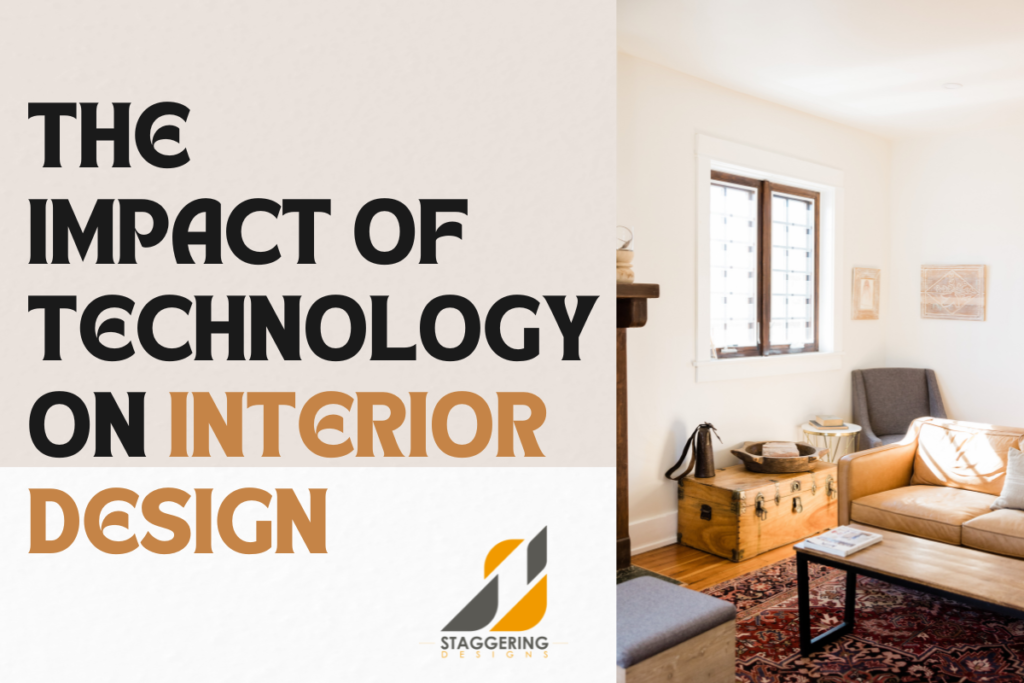Interior Designer – Breaking new ground in the world of interior design, creative fusion with technology has brought possibilities not before seen. Technology, as we travel the information highway, has been an omnipresent shaver, changing the way we think, see, and carry out interior design. This is exploratory work. We’re exploring the deep nature of the relationship between technology and interior design. Staggering Design explores what’s being created for the future of our living spaces.

1. Virtual Reality (VR) and Augmented Reality (AR) Transformations:
VR and AR, are the most widely used technology in interior design. VR and AR are breakthroughs in interior design. Such technologies have transformed the design process, and have given clients the ability to virtually experience their spaces before even a nail has been hammered or paint brushed. They allow designers to create lifelike 3D computer models which clients can interact with and see in lifelike detail every detail of their future interiors, from furniture positioning to colour schemes.
2. Smart Home Integration:
Along with the emergence of smart home technology has come a new era of convenience and efficiency in interior design. It has entered our living spaces in the form of intelligent lighting systems thermostats automatic blinds and security systems. As a result, interior designers are now not just responsible for designing attractive spaces, but must also design spaces that can cope with smart home devices.
3. 3D Printing in Custom Furniture Design:
The emergence of 3D printing has spurred a new wave of creativity in the custom furniture market. It is now possible for interior designers to custom-order intricate items of furniture with unprecedented accuracy. Not only does this increase creative scope but it also makes it possible to pursue more sustainable strategies by increasing manufacturing efficiency and eliminating waste.
4. Artificial Intelligence (AI) in Design Assistance:
Artificial Intelligence has stepped into the design arena, offering valuable assistance to interior designers. AI algorithms can analyse vast amounts of data to predict trends, suggest design elements, and even automate mundane tasks. This allows designers to spend more time on the creative aspects of their work, enhancing the overall quality and efficiency of the design process.
5. Mood Lighting and Smart Controls:
Technology has had a profound effect on the design of lighting. Now smart lighting systems allow homes to transform their spaces at a single touch of a button or a voice command. Interior designers are using these systems to establish flexible and versatile lighting patterns that can change the ambience of a room in an instant.
6. Sustainable Design Solutions:
Sustainable design Interior design is now entering an era in which technology is king. In both form and function, designers are using technology to develop products with an environmental conscience, from recycled materials to smart appliances which go easy on the energy, to meet the global trend towards environmental responsibility.
7. Enhanced Collaboration with Design Software:
Interior design is a very collaborative undertaking. The introduction of advanced software has had a tremendous impact. These tools make it easy for designers, clients, and contractors to communicate. Mood boards, 3D renderings, and virtual walkthroughs can be exchanged at will, macro-smoothing the design process and making sure everyone is up to speed.
8. Online Platforms for Design Inspiration:
In the Internet age, online services and social media have made the Internet a virtual treasure trove of design inspiration. Interior designers now have a platform to easily exhibit portfolios of their work, reach an international audience and keep up with the latest trends. Clients are then able to consider a plethora of design possibilities, and dialogue with the designer becomes informed and animated.
9. Interactive Design Challenges and Social Media Engagement:
The advent of social media has also turned interior design into a participatory activity. Through such powerful social media platforms as Instagram, designers ‘design challenges and interactive polls work together, giving the designer direct access to his audience, and providing fuel for designers’ creative conversations about preferences. Not only does this create a feeling of neighbourhood, it helps designers to stay ahead of the wave of new tastes and preferences.
10. Advanced Project Management Tools:
Technology has introduced a new era of project management for interior designers. From scheduling and budgeting to resource allocation and client communication, project management tools and software streamline the entire design process. This ensures that projects are executed efficiently, deadlines are met, and clients are kept well-informed throughout the journey.
In conclusion, the impact of technology on interior design is nothing short of transformative. From redefining the design process to enhancing sustainability and client engagement, technology has become an indispensable tool for modern interior designers. As we embrace these innovations, we find ourselves at the intersection of creativity and cutting-edge technology, charting a course towards a future where our living spaces are not only aesthetically pleasing but also technologically empowered. The journey continues, and the possibilities are limitless as we navigate the exciting intersection of design and technology.
